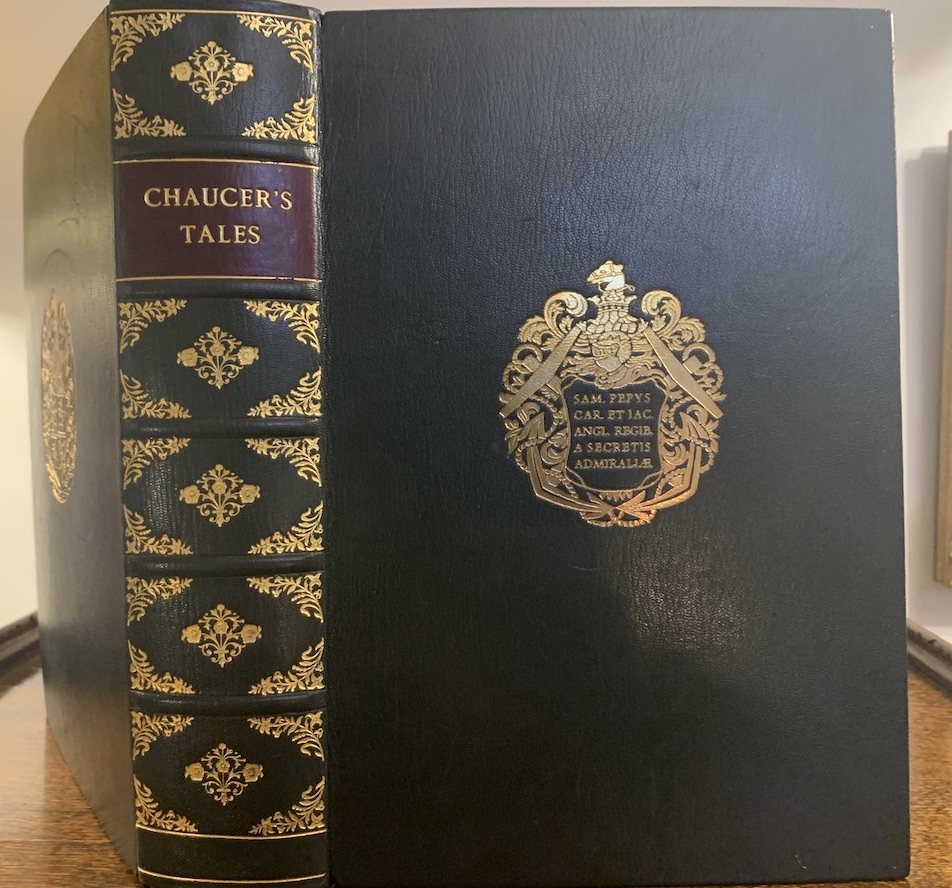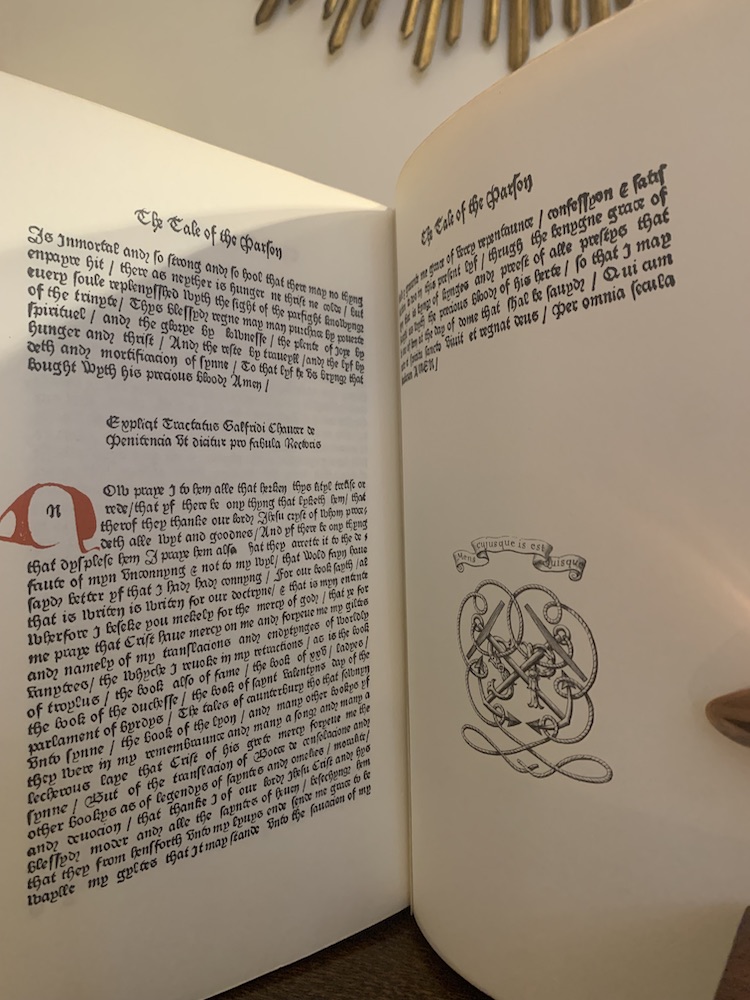William Caxton Facsimile Edition of ‘The Canterbury Tales’

GG sends me a beautiful leather-bound book, The Canterbury Tales, by Geoffrey Chaucer (1343-1400), The William Caxton Facsimile Edition; of which only 500 were published by Cambridge University Press in 1973. She has #248, signed by Cambridge University scholar Walter Hamilton of Magdelene College. On the last page of this huge volume is a wonderful bookplate with the motto: “Mens Cujusque Is Est Quisque” (‘The mind is the man’). This was the personal motto of Samuel Pepys, a scholar and writer of the 17th century who owned the printed 1484 copy from which GG’s fascilie was made.
The diarist and bon vivant Samuel Pepys (1633-1703) left his entire library to Cambridge University upon his death. That magnificent library contained a handwritten diary which Pepys began in 1660 and ended in 1669. Each day he described slices of his exploits; his visits to the theater, music halls, the various actresses he bedded, candid stories of the Court of Charles II and the immoralities there, as well as his career as an Official of the British Navy. This diary of a privileged gentleman of Restoration England became, upon its discovery, a document of immense importance. When the cryptic code in which the diary was written was broken in the 18th century, Pepys’ diary was published, a historical first-source record ever since.
His diary contains eyewitness accounts of the Great Plague of 1665, and the Great Fire of London in 1666. Pepys writes of his own Restoration England’s return to monarchy under Charles II after Oliver Cromwell; a Monarchist, he began his diary the night he accompanied Charles II back to England. A man of boundless energy, he lived a remarkable life with interests in all pleasurable things. One of those pleasures was books; he was a voracious reader. He had a particular love for Chaucer and had amassed poetry volumes and rare manuscripts by Chaucer. GG’s facsimile is a version of the second edition of Chaucer’s Tales (1484). Pepys purchased the book that has been reproduced in GG’s volume in 1696. There are only 13 copies of the 1483 ORIGINAL printing extant. Proof that provenance influences the importance of an object, one of the world’s most influential books was owned by one of the 17th century’s most famous men, and originally printed in the 15th century by England’s first publisher.

Who was the printer who began publishing Chaucer 75 years after the poet’s death? A London merchant of the late 15th century, and one of the first men to operate a British printing press, William Caxton foresaw the importance of The Canterbury Tales, the first book published in England. His first published version of the Tales was from one of 83 manuscripts in 1476. He sold a printed copy to a customer in 1477 who claimed that he had a more complete manuscript, and Caxton’s second edition (1484) was derived from that version. Caxton added an introduction as well as woodcuts depicting 27 of the 31 pilgrims making their way from Tabard Inn in Southwark, London, to Canterbury, Kent to the shrine of Thomas Becket.
California is home to one of those 83 handwritten illustrated manuscripts, the Ellesmere Manuscript of 1400-1403, located at the Huntington in San Marino. I am amazed that as many as 83 manuscripts exist 624 years later: this is perhaps a testimony to the interest in Chaucer’s poetry prior to the arrival of the printing press in England.
The audience for the Tales shortly after the book was first published in 1476 was courtly upper society. As educated upper middle classes of London became readers of Chaucer by the 16th and 17th century, the Tales became the most “printed” book by any English author. Chaucer was the first author to have his works collected in single volume editions as well.
Previous to The Canterbury Tales, the dominant languages for literature in the 14th and 15th century were Anglo-Norman French and Latin. Chaucer is credited as the source of the English vernacular tradition – ours to this day – which legitimized the use of Middle English as the dominant literary language, much like Dante did for the Italian vernacular at about the same time. GG’s facsimile of the 1484 Canterbury Tales, owned by Samuel Pepys in 1696 and reprinted by the Cambridge University Press in an edition of only 500 books, is today sold in UK auctions (I do not find any sales here in the U.S.) for $250; it will become more valuable as time goes on.






